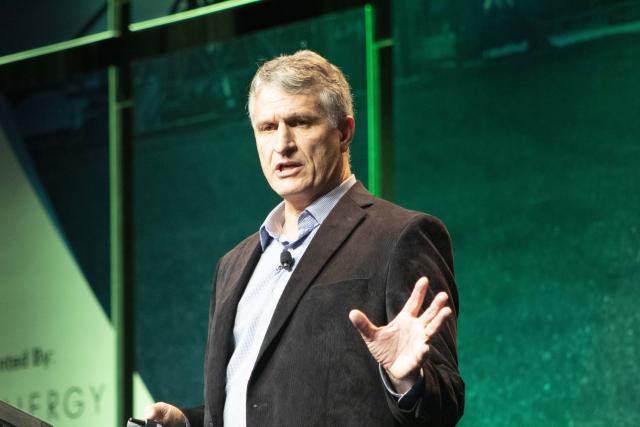
George Grinestaff, CEO, Shale IOR, at Hart Energy’s recent DUG Eagle Ford Conference and Exhibition. (Image: Mary Holcomb, Hart Energy)
SAN ANTONIO—EOG Resources is meeting its appetite for better results in the Eagle Ford through the deployment of its shale EOR program. The company said it is able to yield up to 80% more oil in the Eagle Ford from its gas injection process.
“If you reach your target pressure and you do this process properly, you get 100% of the incremental oil for that well. That’s why the economics are robust [because] there’s not a delay in the IOR production like we’re used to,” George Grinestaff, CEO, Shale IOR, said at Hart Energy’s recent DUG Eagle Ford Conference and Exhibition.
During the production spotlight, Grinestaff presented the case analysis of EOG’s Eagle Ford shale cyclic gas injection process from pilot to full development. In the research, Grinestaff found that conducting gas injection projects in the play’s volatile oil window rewarded the operator huge uplift with optimal gas composition.
With 35 years of experience in reservoir engineering, Grinestaff credits EOG’s success to understanding phase behavior of the stimulation process.
“If you don’t have the phase behavior understood you’re going to go out and make decisions that are not going to give you the robust economics that you can get,” he said. “Anybody can make a reservoir simulation model, but few make one that actually matches the well behavior, the liquid production or the compositional production.”
Taking this information into its pilot, EOG developed a four-well pad in its Martindale unit. After drilling, the wells started on decline, but began producing 150 barrels per day. EOG proceeded to shut-in production before starting the gas injection process, all at once, in the wells for a 30- to 40-day period. Following two years, the compressor was removed and the wells went back to depletion.
From the pilot field results, Shale IOR designed a well oil rate chart that compared historical data against simulated data, which accurately matched the IOR benefit. The history match model of the pilot, Grinestaff said, showed EOG’s injection projects would yield an IOR ratio of 1.75 to 2.00.
“This IOR ratio of 2.0, in the right situations, we can drive up to 3.0. That’s a 300% increase in recovery, so it’s not an insignificant process,” he said.
EOG began full scale development of cyclic gas injection in 2016 with 28 wells between its Mitchell, Henkhaus and Baker Deforest units. The gas stimulation showed a consistent IOR response from hydrocarbon gas injection where oil production grew as gas increased, according to Shale IOR research.
“We see a large uplift with compositional optimization and also with cycle operations,” he said. “Our simulation work shows the process is strong and producing positive cash flow after 15 years. For an economic cycle we cut it off at 10 years, but we see these projects lasting a long time.”
EOG started its most recent EOR projects in its Max, Dullnig, Cheslyn and Inman units that are showing a strong IOR performance, according to the case analysis. The current project is also seeing steady production in the first couple years of gas injection.
Shale IOR indicated that the Eagle Ford volatile oil window is beyond the pilot stage and EOG’s success could be repeated by other operators with reasonable understanding of the process, Grinestaff said.
“We believe the same application for IOR in other unconventional plays such as Permian or Marcellus will be used in the very near future as the wells deplete and approach marginal value,” Shale IOR said in the report. “The process brings life to depleted wells and the payout time is good, yielding robust economics.”
“But, it is not an easy project to cycle these wells and we think you really need to do compositional work. If you don’t, you’ll probably miss the upsides,” Grinestaff said.
Recommended Reading
Defeating the ‘Four Horsemen’ of Flow Assurance
2024-04-18 - Service companies combine processes and techniques to mitigate the impact of paraffin, asphaltenes, hydrates and scale on production—and keep the cash flowing.
Tech Trends: AI Increasing Data Center Demand for Energy
2024-04-16 - In this month’s Tech Trends, new technologies equipped with artificial intelligence take the forefront, as they assist with safety and seismic fault detection. Also, independent contractor Stena Drilling begins upgrades for their Evolution drillship.
AVEVA: Immersive Tech, Augmented Reality and What’s New in the Cloud
2024-04-15 - Rob McGreevy, AVEVA’s chief product officer, talks about technology advancements that give employees on the job training without any of the risks.
Lift-off: How AI is Boosting Field and Employee Productivity
2024-04-12 - From data extraction to well optimization, the oil and gas industry embraces AI.
AI Poised to Break Out of its Oilfield Niche
2024-04-11 - At the AI in Oil & Gas Conference in Houston, experts talked up the benefits artificial intelligence can provide to the downstream, midstream and upstream sectors, while assuring the audience humans will still run the show.





